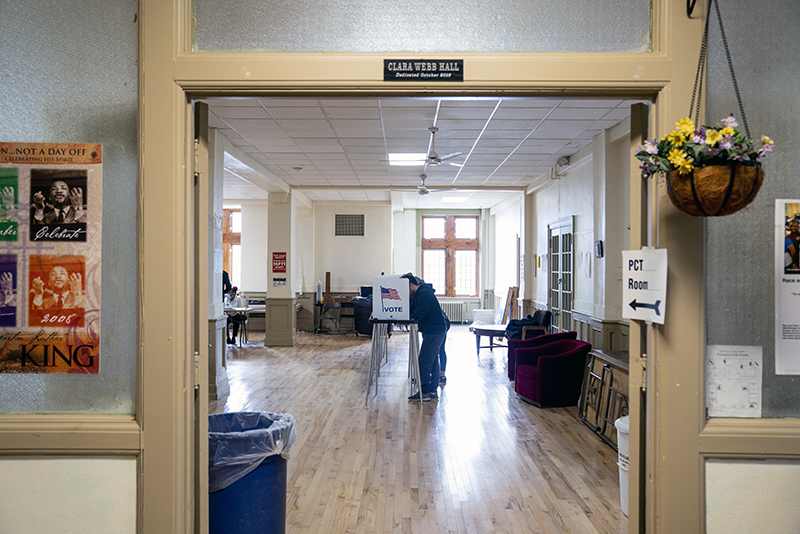AARP Hearing Center
Voter registration: Most U.S. citizens who live in Michigan and are at least 18 years old on Election Day can vote in Michigan’s elections. Registration (and preregistration for certain young people) is available online, by mail or in person. Check your registration using the state’s voter information portal.
Absentee voting: All registered voters can request a no-excuse absentee ballot.
Early in-person voting: Michigan requires at least nine days of early voting for statewide and federal elections. For local elections, early voting is available at the discretion of each city/township voting clerk.
Voting at the polls: Polls are open from 7 a.m. to 8 p.m. Bring an acceptable form of photo ID, such as your driver’s license or U.S. passport. Voters without a photo ID may sign an affidavit and will still be issued a ballot.
Races we’re watching in 2025
Detroit’s mayor, among other positions, is up for election in Michigan in 2025. Primaries were held Tuesday, Aug. 5, and the general election is on Tuesday, Nov. 4. Below are some key dates for the upcoming general election in Detroit. For more information, visit the city of Detroit’s election department.
Voter registration
- Monday, Oct. 20: Deadline to register to vote online or by mail.
- Tuesday, Nov. 4: Deadline to register to vote in person at your local clerk’s office, in line by 8 p.m.
Voting in person
- Saturday, Oct. 25, through Sunday, Nov. 2: Early voting is available in Detroit and may be available in other jurisdictions.
- Tuesday, Nov. 4: Election Day. Polls are open from 7 a.m. to 8 p.m.
Voting by mail
- Friday, Oct. 31: Deadline to submit an absentee ballot application online, by mail (received) or by drop box, by 5 p.m. The secretary of state, however, recommends submitting an application at least 15 days before Election Day — which is Monday, Oct. 20 — to ensure there is enough time to receive and return your absentee ballot.
- Monday, Nov. 3: Deadline to submit an absentee ballot application in person at your local voting clerk’s office, by 4 p.m.
- Tuesday, Nov. 4: Deadline for your local voting clerk’s office to receive your completed absentee ballot, by 8 p.m. (Different deadlines apply for military and overseas ballots.)
- Tuesday, Nov. 4: Deadline for voters newly registering and voters updating their registration with a new address to request and complete an absentee ballot at their local voting clerk’s office, by 8 p.m.

Recent voting changes in Michigan
Laws passed in 2023 made several changes to state election law. Among them:
- Allowing at least nine days of early voting for statewide and federal elections.
- Eliminating a prohibition on hiring transportation to bring voters to polling places.
- Providing state funding for drop boxes and prepaid return envelopes for absentee ballots.
- Expanding the list of acceptable photo IDs.
In March 2024, a federal court approved a new map that altered the boundaries of 15 Detroit-area state House legislative districts.
How to register to vote
- Online: If you have a valid Michigan driver’s license or state ID, you can use the state’s voter registration portal to register.
- By mail: Print a voter registration form, complete it and mail it to your city or township clerk’s office. You also can get a form at your clerk’s office, a Michigan Department of State branch office or a state public assistance agency, or pick one up during a voter registration drive.
- In person: Register at your city or township clerk’s office and bring an acceptable form of ID that proves residency, such as a Michigan driver’s license, state ID card or a paycheck. Voter registration is also offered when you complete a transaction at a secretary of state’s self-service station.
Online, by-mail and in-person registration options are available up to 15 days before Election Day. Within 14 days of Election Day, voters may only register in person at their city or township clerk’s office.
Eligible citizens will be registered to vote automatically when they complete a Michigan driver’s license or ID transaction, unless they opt out.
Registering to vote on Election Day
Register to vote until 8 p.m. on Election Day at your city or township clerk’s office. Show proof of residency, such as a driver’s license or utility bill.
Check your voter registration status
You can check your registration status here.
How to vote in Michigan’s primaries
Michigan voters do not register by party affiliation. Any voter may participate in the primary election of the party of their choice — but they can only participate in one.
How to request an absentee ballot
Any registered voter can request a no-excuse absentee ballot. You can apply:
- Online: Fill out an absentee ballot application on the Michigan secretary of state’s website.
- By mail: Download, print and complete an application from the state’s voter information portal. Send it to your city or township clerk’s office or call your clerk’s office to request an application be mailed.
- In person: Visit your city or township clerk’s office to complete an application.
The deadline to request an absentee ballot online and by mail (application received, not postmarked) is 5 p.m. the Friday before Election Day. The deadline to request one in person is 4 p.m. the Monday before Election Day, unless you are registering to vote or changing your address, in which case you can request and complete an absentee ballot at your local city or township clerk’s office until 8 p.m. on Election Day.
Returning an absentee ballot
Return completed ballots:
- By mail: Sign and seal your completed ballot envelope with the ballot inside and mail it to your city or township clerk’s office. If you’re returning your ballot within two weeks of Election Day, officials recommend hand-delivering your completed ballot or filling out the application in person at your city or township clerk’s office to avoid potential postal delays.
- In person: Return your completed ballot during operating hours to your city or township clerk’s office, early voting location, or polling precinct on Election Day. Note that voters registered in Detroit do not have the option of returning absentee ballots to their polling precinct.
- Drop box: Insert your completed and signed absentee ballot into a drop box in your city or township.
You can find your voting locations or track the status of your absentee ballot on the state’s voter information portal.
Election officials must receive ballots by 8 p.m. on Election Day. Military and overseas ballots postmarked by Election Day will be counted if they are received up to six days after an election.
You may return someone else’s ballot if you are an immediate family member or live in their household, are a mail carrier or an authorized election official.
In the event of an emergency, such as an unexpected illness or death in the family, you may be able to request an emergency absentee ballot by contacting your city or township clerk’s office before 4 p.m. on Election Day.
Voting in person before Election Day
You will have at least nine consecutive days, ending the Sunday before Election Day — and up to 28 days, depending on where you live — to vote in person before all statewide and federal elections. For local elections, early voting is available at the discretion of each city or township voting clerk.
Early voting locations become available on the state’s voter information portal up to 60 days prior to Election Day.
You also can vote early and in person by going to your city or township clerk’s office and filling out an absentee ballot.
Voting at the polls on Election Day
Polls are open from 7 a.m. to 8 p.m. Voters who are in line at their polling location by 8 p.m. on Election Day will be able to vote.
Use the state's voter information portal to find your polling place.
Sample ballots will be available on the secretary of state’s website.
Voter ID requirements on Election Day
An acceptable form of photo ID, such as a Michigan driver’s license or U.S. passport, is required. If you don’t have ID, you can sign an affidavit at the polls before voting.
Voting with a disability
Voters with disabilities can vote at home or in person by applying for a standard absentee voter ballot or an accessible voter ballot.
Inside the polling location, at least one voting station will be adapted to allow a person to vote while seated. All voters have access to a Voter Assist Terminal in all polling places. Voters can mark their ballots using a touch screen through a Voter Assist Terminal, which marks the ballot but does not tally the votes. Once the ballot is marked, it is counted in the same way as other ballots.
Voters who need assistance filling out a ballot can receive help from another person, as long as that person is not the voter’s employer or union official. Get more information at the secretary of state’s website.
Voters with disabilities can contact the Michigan Bureau of Elections Ombudsperson for Accessible Elections for help as well.
Voters who have difficulty reading or writing, are visually impaired or have a physical disability that would interfere with the voting process may apply for an accessible electronic absentee ballot, which can be completed electronically, printed and returned to the clerk. To apply online for an accessible electronic absentee ballot, complete this form.
Voters who live in nursing homes or long-term care facilities can apply for absentee ballots.
Editor’s note: This guide was originally published Jan. 3, 2024, and has been updated with new information about voting in the 2025 elections.































































